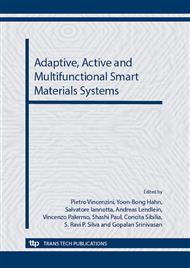[1]
X. Yao, Y. Song, L. Jiang, Applications of bio-inspired special wettable surfaces, Adv. Mater. 23 (2011) 719–734.
DOI: 10.1002/adma.201002689
Google Scholar
[2]
L. Feng, Z. Zhang, Z. Mai, Y. Ma, B. Liu, L. Jiang, D. Zhu, A super-hydrophobic and super- oleophilic coating mesh film for the separation of oil and water, Angew. Chem. Int Ed. 43 (2004) 2012 – (2014).
DOI: 10.1002/anie.200353381
Google Scholar
[3]
X.J. Feng, L. Jiang, Design and creation of superwetting/antiwetting surfaces, Adv. Mater. 18 (2006) 3063 – 3078.
DOI: 10.1002/adma.200501961
Google Scholar
[4]
C. Wang, T. Yao, J. Wu, C. Ma, Z. Fan, Z. Wang, Y. Cheng, Q. Lin, B. Yang, Facile approach in fabricating superhydrophobic and superoleophilic surface for water and oil mixture separation, ACS Appl. Mater. & Interfaces 1 (2009) 2613 – 2617.
DOI: 10.1021/am900520z
Google Scholar
[5]
C.H. Lee, N. Johnson, J. Drelich, Y.K. Yap, The performance of superhydrophobic and superoleophilic carbon nanotube meshes in water–oil filtration carbon 49 (2011) 669 – 676.
DOI: 10.1016/j.carbon.2010.10.016
Google Scholar
[6]
X. Gui, J. Wei, K. Wang, A. Cao, H. Zhu, Y. Jia, Q. Shu, D. Wu, Carbon nanotube sponges, Adv. Mater. 22 (2010) 617 – 621.
DOI: 10.1002/adma.200902986
Google Scholar
[7]
J. Zhang, W. Huang,Y. Han, A composite polymer film with both superhydrophobicity and superoleophilicity, Macromol. Rapid Commun. 27 (2006) 804 – 808.
DOI: 10.1002/marc.200500842
Google Scholar
[8]
J. Yuan, X. Liu, O. Akbulut, J. Hu, S. L. Suib, J. Kong, F. Stellacci, Superwetting nanowire membranes for selective absorption, Nat. Nano. 3 (2008) 332 – 336.
DOI: 10.1038/nnano.2008.136
Google Scholar
[9]
S. Wang, M. Li, Q. Lu, Filter paper with selective sbsorption and separation of liquids that differ in surface tension, ACS Appl. Mater. & Interfaces 2 (2010) 677 – 683.
DOI: 10.1021/am900704u
Google Scholar
[10]
R. Gupta, G.U. Kulkarni, Removal of organic compounds from water by using a gold nanoparticle–poly(dimethylsiloxane) nanocomposite foam, ChemSusChem 4 (2011) 737-743.
DOI: 10.1002/cssc.201000410
Google Scholar
[11]
P. Thanikaivelan, T. Narayanan, B.K. Pradhan, P.M. Ajayan, Collagen based magnetic nanocomposites for oil removal applications, Sci. Rep. 2 (2012) 1-7.
DOI: 10.1038/srep00230
Google Scholar
[12]
S. -J. Choi, T. -H. Kwon, H. Im, D. -I. Moon, D.J. Baek, M. -L. Seol, J.P. Duarte, Y. -K. Choi, A Polydimethylsiloxane (PDMS) sponge for the selective absorption of oil from water, ACS Appl. Mater. Interfaces 3 (2011) 4552-4556.
DOI: 10.1021/am201352w
Google Scholar
[13]
P. Calcagnile, D. Fragouli, I.S. Bayer, G.C. Anyfantis, L. Martiradonna, P.D. Cozzoli, R. Cingolani. A. Athanassiou, Magnetically driven floating foams for the removal of oil contaminants from water, ACS Nano (2012) DOI: 10. 1021/nn3012948.
DOI: 10.1021/nn3012948
Google Scholar
[14]
T. Hyeon, S.S. Lee, V. Park, V. Chung, H.B. Na, Synthesis of highly crystalline and monodisperse maghemite nanocrystallites without a size-selection process, J. Am. Chem. Soc. 123 (2001) 12798-12801.
DOI: 10.1021/ja016812s
Google Scholar
[15]
J. Park, E. Lee, N. -M. Hwang, M. Kang, S.C. Kim, Y. Hwang, J. -G. Park, H. -J. Noh, J. -Y. Kim, J. -H. Park, et al. One-nanometer-scale size-controlled synthesis of monodisperse magnetic iron oxide nanoparticles, Angew. Chem. Int. Ed. 44 (2005).
DOI: 10.1002/anie.200461665
Google Scholar
[16]
L. Zhang, R. He, H. -C. Gu, Oleic acid coating on the monodisperse magnetite nanoparticles Appl. Surf. Sci. 253 (2006) 2611 – 2617.
DOI: 10.1016/j.apsusc.2006.05.023
Google Scholar
[17]
A.L. Willis, N. J. Turro, S. O'Brien, Spectroscopic characterization of the surface of iron oxide nanocrystals, Chem. Mater., 17 (2005) 5970 – 5975.
DOI: 10.1021/cm051370v
Google Scholar
[18]
H. Teisala, M. Tuomine, M. Aromaa, M. Stepien, J.M. Mäkelä, J.J. Saarinen, M. Toivakka, J. Kuusipalo, Nanostructures increase water droplet adhesion on hierarchically rough superhydrophobic surfaces. Langmuir 28 (2012) 3138—3145.
DOI: 10.1021/la203155d
Google Scholar
[19]
R.N. Wenzel, Resistence of solid surfaces by wetting by water, Ind. Eng. Chem. 28 (1936) 988 – 994.
DOI: 10.1021/ie50320a024
Google Scholar
[20]
A.B.D. Cassie, S. Baxter, Wettability of porous surfaces, Trans. Faraday Soc. 40 (1944) 546-551.
DOI: 10.1039/tf9444000546
Google Scholar
[21]
A.B.D. Cassie, Discuss. Faraday Soc. 3 (1948) 11 – 16.
Google Scholar
[22]
G. McHale, N.J. Shirtcliffe, M.I. Newton, Super-hydrophobic and super-wetting surfaces: Analytical potential?, Analyst 129 (2004) 284 – 287.
DOI: 10.1039/b400567h
Google Scholar
[23]
B.S. Ko, B. Babcock, G.K. Jennings, S.G. Tilden, R.R. Peterson, D. Cliffel, E. Greenbaum, Langmuir 20 (2004) 4033 – 4038.
DOI: 10.1021/la0356809
Google Scholar


